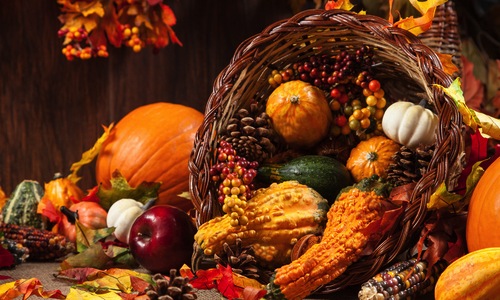

Take these small steps to make your Thanksgiving celebration more environmentally friendly:
1. Use the good dishes and cloth napkins. Disposable dishes and plastic utensils create a ton of waste. If reusable won’t work, choose disposable plates, cups, napkins and utensils made from 100 percent post-consumer waste recycled paper, sugarcane and corn—they are compostable, too.
2. Decorate with nature. Forget the petroleum-based plastic and synthetic decorations and adorn your table with natural and homemade festive decor. Fill clear vases with pinecones, acorns and colorful leaves. Popped open your organic wine bottles already? Carve a small slit in the corks, and slide in a piece of paper with a guest’s name to create unique, upcycled place settings.
3. Use reusable or borrow rather than buy. Choose reusable leftover containers and cookware or borrow extra dishes, platters and special bakeware. If you’re going to someone else’s house, bring your own reusable container for leftovers.
4. Take a look at your energy use. If you have several dishes that need to be in the oven at the same temperature, put them in at the same time to reduce energy use and prep time. Start some of your ingredients, like butter, at room temperature to reduce stove-top melting time.
5. Stay close to home or carpool. There’s no way around it: traveling miles and miles to share a single meal with family and friends is not the greenest of ways to spend a Thanksgiving. Sticking closer to home means a smaller carbon footprint. If you are attending a large family gathering for Thanksgiving, carpool with other family members. Make sure your tires are inflated properly.
6. Prepare less food. Everybody feels compelled to put a huge turkey in the oven and prepare numerous courses. Choose a smaller bird and skip some of the less-popular dishes to reduce food waste.
7. Use smaller plates for less food waste. Kids tend to eat small amounts and then leave to play while adults tend to fill their plate with everything that looks appealing. A smaller plate means your guests will choose less in the first place.
8. Shop local and organic. Why not pay your local farmer a visit? Buying local and sustainable food can help create jobs and grow our rural and urban economies, preserve farmland and improve the environment and provide fresh and healthy food to our family and friends. Use the Natural Resources Defense Council’s buy local app to find a farmers market near you and check out what is in season ahead of time.
9. Compost your kitchen scraps. Composting kitchen scraps can have a big impact. Twenty-four percent of the waste Americans send to landfills is organic waste, meaning kitchen scraps. Keeping that waste out of landfills doesn’t just save space, it also reduces greenhouse gas emissions, as decomposition in landfills creates methane, a greenhouse gas 21 times more potent than carbon dioxide.
10. Serve tap water. Bottled water creates plastic waste, isn’t safer than tap water, is expensive to buy and is often just tap water in a bottle.
11. Use candles made from soy or vegetable wax. Soy wax is clean-burning, without soot or harmful emissions, and has a low melting point so it burns at a cooler temperature.
12. Bring a local or organic bottle of wine for your hosts. Many wineries, such as Fetzer, are making efforts to be a sustainable business. You can also look for the Eco Glass label on many different bottles of wine. Eco Glass uses 25 percent less glass than traditional wine bottles, saving materials and shipping weight, which saves delivery truck fuel use.

 233k
233k  41k
41k  Subscribe
Subscribe 

